Freesia: [Planting, Care, Irrigation, Substrate, Flowering and More]
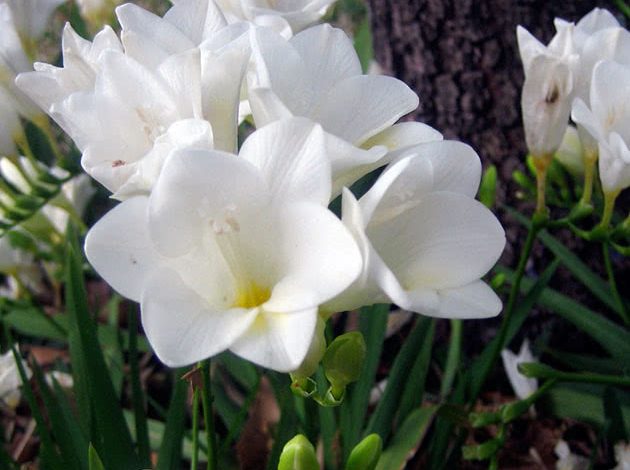
Important points when planting Freesia
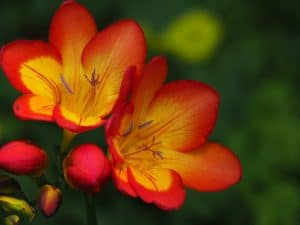 When? There are cold regions where it is preferable to sow it in spring to avoid harmful frosts. Autumn is also a good time to plant bulbs in the garden and pots.
When? There are cold regions where it is preferable to sow it in spring to avoid harmful frosts. Autumn is also a good time to plant bulbs in the garden and pots.- Where? It thrives and lives long in places with a temperate climate, where there is neither oppressive heat nor frigid cold. It can be outdoors and at home, on a terrace.
- How do we prepare the land? A good substrate with a neutral pH, with a good drainage system is ideal. Use garden soil with a mixture of equal parts perlite or vermiculite.
- How do we sow? By seeds and by corms or bulbs sown in the garden and in pots, under good sunlight and even in greenhouses.
- How do we pay? Every two weeks, a good liquid fertilizer can be used in the growth period of the plant to strengthen the shoot.
- When do they bloom? In spring, it lavishes a wonderful visual spectacle. 10 to 12 weeks after planting corms is their normal flowering cycle.
- Ideal temperature? The ideal temperature for this shrub ranges from 18ºC to 22ºC. Does not tolerate very low temperatures. The bulbs must be protected from frost.
- How do we water? Drip isideal. Watering should be prudent, not exaggerated. About 2 times a week will be fine to prevent its roots from rotting.
- Diseases and pests? It is very resistant, but you have to take care of the fungal plant, Brotitis and Gray Rot. It is attacked by red spiders, slugs and snails.
What is Freesia?
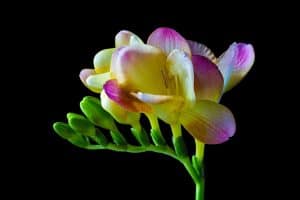 The Freesia or Fresia or Strawberry, belonging to the Iridaceae family, is a bulbous herbaceous plant originally cultivated on the African continent, from where around 15 species have come, most of them from South Africa.
The Freesia or Fresia or Strawberry, belonging to the Iridaceae family, is a bulbous herbaceous plant originally cultivated on the African continent, from where around 15 species have come, most of them from South Africa.
It has the particularity that it has buried stems, which remain underground, called corms. The base is always more thickened or swollen and has vertical growth.
Its flowers have a very striking image and are made up of unilateral spikes, with an exquisite fragrance.
Today there are many beautiful colors achieved by growers of spectacular hybrid varieties, in shades of white, lavender, pink, yellow, orange, blue and red. Although its original color is yellow or orange.
Each flower is born next to an elongated stem, shaped like little spikes. Each stem can hold between 5 to 8 single or double flowers.
It is very generous, because it offers a great visual spectacle in spring without asking for much in return. It requires little care. It’s very tough. And it lives perfectly well in a pot or in your home garden.
Where should we plant freesia?
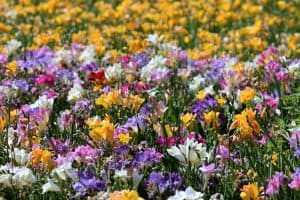 The ideal is to plant it in a garden with good drainage, where it receives good natural light and has a drip irrigation system where there is no puddle or stagnation of water.
The ideal is to plant it in a garden with good drainage, where it receives good natural light and has a drip irrigation system where there is no puddle or stagnation of water.
But you can also have it at home, in an exclusive place for it where it receives indirect light and a lot of love and dedication, although as has already been said, freesia does not require more care.
It flowers freely as long as it is planted in fertile, well-drained soil.
When should freesia be grown?
It is a very noble plant. It should be cultivated about 3 months before the flowering period, before the winter season, and it is absolutely essential to leave a reasonable space of about 5 centimeters between each corm and a recommended depth of about 10 centimeters, to promote normal growth.
Liquid fertilization, with organic products, is very convenient for buds, when the plants are young and in flower. The recommended frequency is to do it every two weeks
How do we prepare the land?
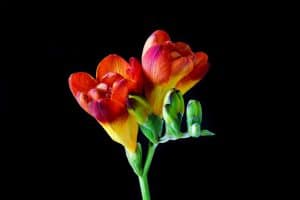 Although it comes from the untamed African continent, specifically from the Cape in South Africa, this beautiful floral species can grow almost anywhere, both in gardens and in spacious pots where it blooms every spring.
Although it comes from the untamed African continent, specifically from the Cape in South Africa, this beautiful floral species can grow almost anywhere, both in gardens and in spacious pots where it blooms every spring.
A garden soil preparation of equal parts vegetable mulch and sand is a good choice for potted Freesia.
A neutral pH, a slightly acid soil, is widely accepted for this herbaceous plant of great beauty and intense aroma.
How to plant a freesia step by step?
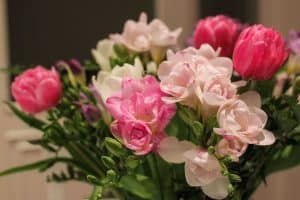 There are two methods of growing this beautiful bulbous herb. By corms and with the help of seeds.
There are two methods of growing this beautiful bulbous herb. By corms and with the help of seeds.
The corms are buried stems that grow to a maximum height of about 50 centimeters, revealing soft green deciduous leaves.
To sow it, it is necessary to look for these bulbs in a nursery or trusted store, in autumn, because they will be tender and firm at that time.
When you have planted them, they should be submerged in water for about 30 minutes, since those that come packed will be dehydrated.
They should never be planted in winter. Autumn, with warm weather, is the most favorable date. But if the weather in that period is unstable, with cold winds, or you live in a country with severe winter, it can be done in the spring and there are no risks.
Let’s see now, step by step, how to plant the Freesia corms or bulbs.
bulbs in garden
- Select a good space in the garden, where the lighting is generous in the mornings, or in partial shade, but where the soil is always well drained.
- For each bulb to be planted, it is necessary to open a hole in the ground about 25 centimeters deep, in order to aerate the soil when it is stirred.
- It is convenient to place a good fertilizer for bulbs or bone meal at the bottom of the hole, to help strengthen the future plant.
- The bulbs should be planted with the tip facing the sky, upwards and it is necessary to cover them with soil, with 2 or 3 centimeters. Between each bulb, the separation should be about 7 centimeters, to leave them a good space for the roots to develop.
- Additionally, they can help the plant stand up with a stake made of bamboo material.
- It is very important to start watering with prudent generosity, in order to avoid drowning. But it needs constant moisture from the earth so that the bulb can be fixed with the help of healthy roots.
bulbs in pots
- You should look for a pot that is around 12 to 15 inches in diameter. With this measurement range, about 15 to 20 bulbs can be planted. In a pot of 25 centimeters, about 12 bulbs can be planted and if it is smaller, then in about 20 centimeters you can have about 9 bulbs.
- It is necessary to choose a well-ventilated place with enough natural light when the pot is placed in an interior space of the house. A terrace or balcony will be very helpful.
- Immediately afterwards, it is necessary to fill the pot with a universal culture substrate to which perlite will be added, in a proportion of 50-50.
sowing by seed
This technique is more complicated, because some specialists in the area indicate that flowering can be greatly delayed, but it also depends on the conditions of light, humidity, temperature and irrigation.
- Here it is convenient to use a special substrate, composed of two parts of sterilized compost, sand, peat and mineral perphosphate to sow seeds that are previously submerged in water for 24 hours to soften them.
- Locate a pot or seedbed about 10 centimeters in diameter and add a universal substrate also mixed with pearls in equal parts. It also works to use vermiculite.
- About 3 to 4 seeds will be placed on the surface of the substrate, spreading with the accompaniment of a small dose of sulfur, because in this way the proliferation of fungi is avoided. And on top of that, you have to add more substrate, very delicately.
- Water with the help of a spray container, so that the water is administered very well on the surface of the earth.
- Place in a ventilated place, with a lot of sun or semi-shade, taking care that the substrate is always kept moist or the seeds will not germinate, which will give good news about 15 days later.
Freesia Bloom Time
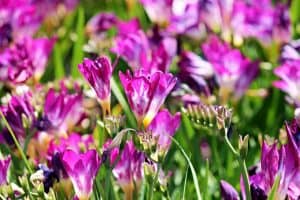 Flowering will start about 12 weeks after you’ve planted the corms and one technique to extend this flowery production is to do more plantings sequentially every two weeks.
Flowering will start about 12 weeks after you’ve planted the corms and one technique to extend this flowery production is to do more plantings sequentially every two weeks.
What care does freesia need?
- It can live indoors in semi-shade, but it is actually happier outdoors, receiving the sun’s rays.
- It needs a well-managed watering, with twice a week it will be more than enough for it, since it does not tolerate excess water or puddles.
- Freesia supports low temperatures, but up to an estimated range of -2ºC. No more of that. So it is very convenient to take care of it from winter frosts that can kill it.
- Fertilizer in the flowering period is very convenient. You can use an organic type or a good reliable liquid fertilizer that will be applied every 2 weeks.
What pests and diseases does it have?
The Freesia is a very resistant plant, but you have to take care of it from the attack of fungi.
However, changes in the coloration of its leaves may occur. If it suffers from Fusarium, the damaged leaves must be eliminated quickly and sometimes the disease takes hold of the root, so the entire diseased section must be removed.
Another disease that attacks it is Brotitis or Gray Rot, with horrendous gray spots on leaves and flowers.
They suffer from the presence of the red spider, a very persistent pest in crops that are kept in greenhouses. It is also visited by undesirables such as snails and slugs, as well as aphids.

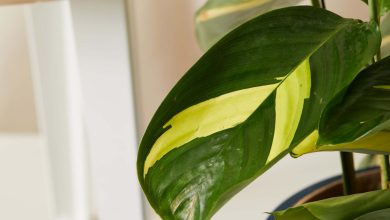
![Photo of Nabicol or Kohlrabi: [Cultivation, Care, Irrigation, Substrate and Pests]](https://www.complete-gardening.com/wp-content/uploads/2022/08/nabicol-or-kohlrabi-cultivation-care-irrigation-substrate-and-pests-390x220.jpg)
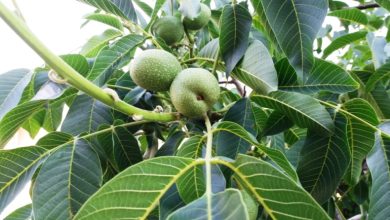
![Photo of Dandelion: [Care, Planting, Characteristics, Irrigation and Substrate]](https://www.complete-gardening.com/wp-content/uploads/2022/08/dandelion-care-planting-characteristics-irrigation-and-substrate-390x220.jpg)